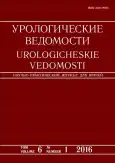Lower urinary tract symptoms in male population of the Russian Federation North-Western Region: analysis of population study results
- 作者: Korneyev I.A1, Alexeeva T.A2, Al-Shukri S.H1, Pushkar D.Y.3
-
隶属关系:
- First State Pavlov Medical University of St Petersburg
- National Research University Higher School of Economics
- Moscow State Evdokimov Medical and Dental University
- 期: 卷 6, 编号 1 (2016)
- 页面: 5-9
- 栏目: Articles
- ##submission.dateSubmitted##: 22.06.2016
- ##submission.datePublished##: 15.03.2016
- URL: https://journals.eco-vector.com/uroved/article/view/3013
- DOI: https://doi.org/10.17816/uroved615-9
- ID: 3013
如何引用文章
详细
全文:
作者简介
Igor Korneyev
First State Pavlov Medical University of St Petersburg
Email: iakorneyev@yandex.ru
doctor of medical science, professor, Urology Department
Tatyana Alexeeva
National Research University Higher School of Economics
Email: tatyanalexeeva@gmail.com
candidate of medical science, associate professor of the Applied Mathematics and Business Informatics Department
Salman Al-Shukri
First State Pavlov Medical University of St Petersburg
Email: al-shukri@mail.ru
doctor of medical science, professor, head of the department. Department of Urology
Dmitriy Pushkar
Moscow State Evdokimov Medical and Dental University
Email: pushkardm@mail.ru
doctor of medical science, chief urologist of the Ministry of Healthcare, professor, head of the department. Department of Urology
参考
- Kupelian V, Wei JT, O’Leary MP, et al. Prevalence of lower urinary tract symptoms and effect on quality of life in a racially and ethnically diverse random sample: the Boston Area Community Health (BACH) survey. Arch Intern Med. 2006;(166):2381-2387.
- Taylor BC, Wilt TJ, Fink HA, et al. Prevalence, severity and health correlates of lower urinary tract symptoms among older men: the MrOS study. Urology. 2006;(68):804-809.
- Abrams P, Cardozo L, Fall M, et al. The standardisation of terminology of lower urinary tract function: report from the Standardisation Sub-committee of the International Continence Society. Neurourol Urodyn. 2002;21(2):167-178.
- Chapple CR, Wein AJ, Abrams P, et al. Lower Urinary Tract Symptoms Revisited: A Broader Clinical Perspective. Eur Urol. 2008;54(3):563-569.
- Kupelian V, McVary KT, Kaplan SA, et al. Association of lower urinary tract symptoms and the metabolic syndrome: results from the Boston area community health survey. J Urol. 2013;189(1):107-114.
- Корнеев И. А., Алексеева Т. А., Аль-Шукри С.Х., и др. Распространенность симптомов нижних мочевых путей у мужчин в Российской Федерации: анализ результатов популяционного исследования // Georgian Medical News. - 2015. - Т. 4. - № 241. - С. 7-14.
- Пушкарь Д. Ю., Камалов А. А., Аль-Шукри С.Х., и др. Анализ результатов эпидемиологического исследования распространенности эректильной дисфункции в Российской Федерации // Урология. - 2012. - № 6. - С. 5-9.
- Kogan MI, Zachoval R, Ozyurt C, et al. Epidemiology and impact of urinary incontinence, overactive bladder, and other lower urinary tract symptoms: results of the EPIC survey in Russia, Czech Republic, and Turkey. Curr Med Res Opin. 2014;30(10):2119-2130.
- Pintarelli VL, Perchon LF, Lorenzetti F, et al. Elderly men’s quality of life and lower urinary tract symptoms: an intricate relationship. Int Braz J Urol. 2011;37(6):758-765.
补充文件







